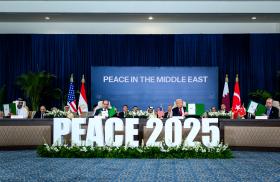
- Policy Analysis
- PolicyWatch 4123
China’s Push for Satellite Cooperation in the Middle East

By investing in relationships with scientists in the region, Beijing is seeking to fortify its own BeiDou system and drive growth, offering potential lessons for Washington.
In late September, China hosted the fifth China–Arab states BeiDou Cooperation Forum. Launched in 2017 with scientists from the Arab League and the China National Space Administration, the forum is designed to advance the compatibility and uptake of China’s BeiDou satellite system.
BeiDou is one of several such global navigation satellite systems (GNSS) in operation around the world today. Others include the U.S. Global Positioning System (GPS), Russia’s Global Navigation Satellite System (GLONASS), Japan’s Quasi-Zenith Satellite System (QZSS), India’s Navigation with Indian Constellation (NavIC), and the European Union’s Galileo. These systems, while developed primarily for their defense capabilities, also have numerous important civilian applications for agriculture, fishing vessels, civil aviation, consumer electronics, and more.
Many Middle East countries are eager to develop interoperability with existing satellite systems for those commercial and scientific applications, and China is emerging as the most proactive advocate of its own system. This convergence prompts two questions: What are the military implications, and how should the United States respond?
China’s Satellite Ambitions
China began working on BeiDou soon after the United States launched its Strategic Defense Initiative, known as “Star Wars,” in 1983. Despite lagging technologically and economically at the time, China determined that this project would be a priority during the period 1986–2000, and by 1989 BeiDou had successfully completed its feasibility test. Nevertheless, Chinese officials were concerned about their overreliance on the American GPS, which was then the only system of its kind.
Beijing’s concerns were validated during the Yinhe incident in July 1993, when the United States alleged that a Chinese civilian container ship was transporting chemical weapons materials to Iran. The United States jammed the ship’s GPS signals, forcing it to anchor on the high seas for three weeks while Washington pressured Beijing to either turn the vessel around or accept an inspection. Eventually, China conceded and the vessel docked in Saudi Arabia for an inspection by Chinese, Saudi, and U.S. officials, who found no evidence of chemical weapons materials. Chinese media today frequently reference the incident when discussing BeiDou’s development.
Another incident occurred during the Taiwan Strait crisis of 1995–1996, when the island nation’s then-President Lee Teng-hui visited the United States and delivered a speech about his “country with independent sovereignty.” In response, China announced military exercises in the East China Sea but lost track of two missiles launched because the United States briefly denied it GPS access. A senior military official later described this moment as an “unforgettable humiliation” that spurred China’s efforts to build its own GNSS.
BeiDou subsequently completed its first phase of satellite launches in 2003, its second phase in 2012, and its third and final phase in 2020. It is now fully operational, and according to experts, more technologically advanced than any other GNSS currently available.
The Middle East–BeiDou Link
The September BeiDou Cooperation Forum highlighted the Middle East as China’s most important focus for uptake of its navigation system after Southeast Asia. Since 2017, China has held five BeiDou conferences with the Arab League but only two with African, central Asian, and “international” groups, respectively.
This is likely because many Middle East countries—including Saudi Arabia, the United Arab Emirates, Bahrain, and Turkey—have ambitions to engage in space- and satellite-related activities, as well as the money to see their plans through. All have established space agencies yet rely on foreign powers like China and the United States to sell them the equipment and services to make their aspirations a reality. Meanwhile, China is still interested in collaborating with less-wealthy Middle East countries, and BeiDou’s first overseas ground station was established in Tunisia in 2018.
The Yinhe incident also likely highlighted for China the extent to which its reliance on foreign systems rendered its fleet of seaborne oil and gas tankers vulnerable. For a country that depends on overseas sources for roughly 74 percent of its oil imports, much from the Middle East, ensuring that ships are equipped with reliable satellite navigation systems is particularly important in the event of a crisis.
Finally, the positioning, navigation, and timing (PNT) systems that depend on GNSS are trending toward the use of “multi-constellation” receivers. This means they work with several systems simultaneously to receive the best available data, especially should a given satellite system become temporarily unavailable. This is true not only for commercial aviation, ships, and scientific equipment, but also for almost all consumer devices today. For example, the latest iPhones on the U.S. market are designed to use China’s BeiDou as well as Russia’s GLONASS. Scientists in the Middle East, in turn, will understandably seek to ensure that their systems are as interoperable with BeiDou as with GPS and other systems.
Potential Risks for the United States
Another aspect of the trend toward “multi-constellation” receivers is that no country can now exert the leverage the United States employed against China in the 1990s. Some countries may consider removing GPS functionality from their systems in extreme cases, as Iran did after the June 2025 twelve-day war with Israel, but even then such a move is unlikely to tip the scales overwhelmingly in BeiDou’s favor. This is because any such country would almost certainly still maintain interoperability with other international systems to ensure resilience.
Even the U.S. National Security Council discussed adopting BeiDou compatibility across critical infrastructure in order to create redundancy and add a strategic buffer with China. Such an argument relies on the understanding that GNSS signals are simply one-way radio broadcasts of time and satellite position that cannot transmit data back to China and are therefore of limited intelligence value on their own.
The United States and its partners would have cause for concern, however, if the chipsets used in terrestrial devices—phones, weapons, scientific research equipment—were also sending signals to the satellites. In technical terms, they would need to be transceivers, which transmit and receive signals, rather than just receivers. The BeiDou satellite system is unique among its GNSS peers for being able to receive messages of up to 1,200 characters, making the concern more than an abstraction: China could be selling transceiver chipsets to third-party countries—or devices with transceivers already installed—in order to boost its intelligence-gathering capabilities.
Finally, the United States is also likely concerned about the infrastructure China may be seeking to develop in the Middle East to support BeiDou’s terrestrial network. More ground stations and the sale of related services such as satellite launches mean China has access to a growing network of more precise information. For data-gathering operations, China would not have to wait until satellites crossed over the Chinese mainland to download information but could access those satellites from abroad. Furthermore, once foreign countries launch their satellites via Chinese vendors to support domestic sectors such as agriculture and logistics, they will depend on Chinese scientists and technicians for their upkeep.
Conclusions and Policy Recommendations
Despite BeiDou’s various forums and technological achievements, China still lags behind the United States, with roughly 2 billion BeiDou devices worldwide, compared to an estimated 7 billion active GPS devices. But in contrast to China-hosted forums with the Arab League and other such entities to drive uptake, the United States does not host region-specific forums. Instead, it engages with international communities of scientists through channels like the UN’s International Committee on Global Navigation Satellite Systems (ICG) and the Civil GPS Service Interface Committee (CGSIC), which will hold its sixty-fifth conference next year.
These engagements, which aim to ensure GPS interoperability, are also less focused on driving adoption than are China’s BeiDou forums. This is perhaps a reflection of U.S incumbency advantages, since most countries’ PNT systems have long been equipped to use GPS. Thus, in large part, the main U.S. focus should simply be to improve GPS toward addressing its own technological needs and those of its partners. Nevertheless, Washington could still increase collaborations and scholarships beyond the ICG and CGSIC forums, if only to build deeper networks and generate localized knowledge between U.S. and Middle East scientists.
Furthermore, the United States does not necessarily need to compete with China for ground stations in the current GPS generation, and it may well be able to design the next generation based on the existing terrestrial infrastructure. But if it wishes to compete with China in the launching of satellites for Middle East partners, it must get creative with NASA and the private sector. Currently, NASA’s collaborations are primarily scientific, while Starlink mostly sells to advanced economies. China offers the full range of its technological satellite expertise to Middle East countries, in part to fortify its own system and drive growth. The United States should consider expanding its horizons and doing the same.
Ultimately, the space race has become wider and deeper than it was in the twentieth century. More countries have higher aspirations, and more suppliers are willing to share technologies to foster collaboration and growth. China understands that deepening ties helps fuel its satellite industry’s rise; the United States should too. And the Middle East is key to both.
Henry Tugendhat is a Soref Fellow in The Washington Institute’s Diane and Guilford Glazer Foundation Program on Great Power Competition and the Middle East.



